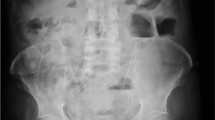Abstract
Jejunal diverticulosis is a rare asymptomatic entity [1]. In literature, there are only few cases of jejunal diverticulosis where small gut volvulus is reported. The disease entity is important as it may masquerade as hemorrhage, obstruction, or perforation which are life threatening. We report a rare case of small bowel volvulus secondary to jejunal diverticulosis.
Similar content being viewed by others
Avoid common mistakes on your manuscript.
Introduction
The incidence of Jejunal diverticulosis ranges from 0.1 to 1.5 % noted in upper gastrointestinal studies [2].
Mechanical intestinal obstruction occurs in 2.3–4.6 % of cases of jejunoileal diverticulosis. Obstruction caused by inflammatory stenosis, intussusceptions, volvulus, and voluminous jejunal stones have been described. Our case had recurrent abdominal pain of 6 months duration. Contrast-enhanced computerized tomography (CECT) abdomen revealed mesenteric volvulus. On laparotomy, a small gut volvulus secondary to jejunal diverticulosis was found.
Case Report
A 54-year-old male was suffering from colicky abdominal pain, distended abdomen, and vomiting of 1-week duration. He had recurrent attacks of similar symptoms and dyspepsia for the last 6 months. Each episode was aggravated by taking food and relieved on taking rest. On abdominal examination, there was distension and tenderness. No visible intestinal peristalsis noted. Bowel sounds were exaggerated. His vitals were stable.
Routine blood investigations revealed no abnormality except for low hemoglobin value of 8.6 g/dl. Plain X-ray of abdomen in erect position showed dilated small bowel loops. CECT of the abdomen revealed “whirl sign” suggesting intestinal volvulus.
Laparotomy revealed a 50-cm segment of jejunum with mesenteric diverticulae and a loop of normal looking bowel twisted two and a half times in counterclockwise direction (Fig. 1 mesenteric volvulus). Though signs of diverticulitis were absent, multiple enlarged mesenteric lymph nodes were noticed. Bowels were viable. To avoid future recurrence, resection and jejunojejunal anastomosis were performed (Fig. 2 volvulus of small bowel). Post-operative period was uneventful.
Discussion
Jejunal diverticulae are false diverticulae and are usually multiple, protruding from the mesenteric border of the bowel. The cause of jejunoileal diverticulosis is thought to be a motor dysfunction of the smooth muscle or the myenteric plexus [3], generating increased intraluminal pressure.
Jejunoileal diverticulae are usually found incidentally at laparotomy or upper gastrointestinal study. The great majority remain asymptomatic. Clinical symptoms may include abdominal pain, steatorrhea, hypoproteinemia, megaloblastic anemia, neuropathy, and inflammation. Acute complications such as intestinal obstruction, hemorrhage, or perforation can occur but are rare. Chronic symptomatology includes vague chronic abdominal pain, malabsorption, functional pseudo-obstruction, and chronic low-grade gastrointestinal hemorrhage. Obstruction is less common complication, with an estimated incidence of 5 % and only 27 cases described in literature. Bowel obstruction may be a consequence of adhesions, stricture, volvulus, intussusception, or enterolith.
If a small bowel volvulus is found in an adult, small bowel diverticulosis should be considered, as there is an association between the two conditions [4].
Enteroclysis is specific investigation for the jejunal diverticulosis. In recent years, endoscopy has replaced enteroclysis [5].
In acute abdomen due to small bowel volvulus, repeated physical and radiological examinations are recommended. CT examination and angiographic study are helpful in diagnosis. The “whirl sign” on abdominal CT refers to a whirling or spiral shape of the mesenteric vessels, which may accompany the intestinal loops and their feeding vessels and has sensitivity in predicting the presence of small bowel obstruction necessitating surgery [6].
For incidentally noted, asymptomatic jejunoileal diverticulae, no treatment is required. Treatment of complications is usually by intestinal resection and end-to-end anastomosis. Management of malabsorption is with antibiotics, obstruction due to enteroliths is by enterotomy and removal, and perforation by resection with anastomosis.
Conclusion
Jejunal diverticulosis is rare and mostly asymptomatic. It can sometimes produce life-threatening complications like hemorrhage, inflammation, perforation, and obstruction. Jejunal diverticulosis causing small gut volvulus and obstruction is even more rare presentation. A high degree of suspicion is necessary in view of the high mortality and morbidity rates resulting from a delayed diagnosis. However, promising results are seen with resection of involved jejunal segment and end to end anastomosis.
References
Chow D, Babaian M, Taubin H (1997) Jejunoileal diverticula. Gastroenterologist 5:78
Scully R, Mark E (1990) Case records of the Massachusetts general hospital. N Engl J Med 322:1796
Krishnamurthy S, Kelly MM, Rohrmann CA (1983) Jejunal diverticulosis: a heterogeneous disorder caused by a variety of abnormalities of smooth muscle and myenteric plexus. Gastroenterology 85:538
Feldman M, Friedman LS, Brandt LJ (2010) Sleisenger and Fordtran’s Gastrointestinal and liver disease. 9th ed 1(23):377
Nagi B, Khandelwal N, Gupta R (1991) Role of enteroclysis in acquired small bowel diverticula. Indian J Gastroenterol 10:31
Balthazar EJ, George W (1994) Holmes lecture. CT of small-bowel obstruction. AJR Am J Roentgenol 162:255–261
Author information
Authors and Affiliations
Corresponding author
Rights and permissions
About this article
Cite this article
Reddi, B.R., Konkena, J.R., Bogarapu, C.B. et al. A Rare Case of Jejunal Diverticulosis Causing Mesenteric Volvulus. Indian J Surg 77, 150–151 (2015). https://doi.org/10.1007/s12262-015-1293-9
Received:
Accepted:
Published:
Issue Date:
DOI: https://doi.org/10.1007/s12262-015-1293-9






